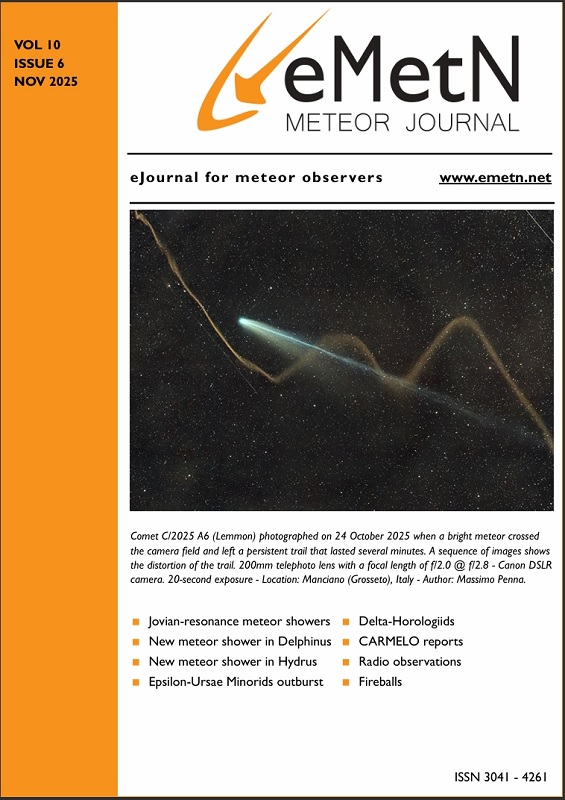Mariasole Maglione (Gruppo Astrofili Vicentini)
Lorenzo Barbieri (CARMELO network and AAB: Associazione Astrofili Bolognesi)
Introduction
November is dominated by the Leonid meteor shower (LEO), the maximum of which was observed by the CARMELO network on November 17. Data collected confirm activity consistent with predictions.
Methods
The CARMELO network consists of SDR radio receivers. In them, a microprocessor (Raspberry) performs three functions simultaneously:
- By driving a dongle, it tunes the frequency on which the transmitter transmits and tunes like a radio, samples the radio signal and through the FFT (Fast Fourier Transform) measures frequency and received power.
- By analyzing the received data for each packet, it detects meteoric echoes and discards false positives and interference.
- It compiles a file containing the event log and sends it to a server.
The data are all generated by the same standard, and are therefore homogeneous and comparable. A single receiver can be assembled with a few devices whose total current cost is about 210 euros.
To participate in the network read the instructions on this page.
November data
In the plots that follow, all available at this page, the abscissae represent time, which is expressed in UT (Universal Time), and the ordinates represent the hourly rate, calculated as the total number of events recorded by the network in an hour divided by the number of operating receivers.
In fig.1, the trend of signals detected by the receivers for the month of November.

Fig. 1: November 2024 data trend.
Leonids
In November, the main character is the ancient Leonid meteor shower (LEO). The shower originated from the periodic Halley-type comet called 55P/Tempel-Tuttle, which is characterized by an orbital period of about 33 years.
Over the past two decades, the number of fragments left behind by the comet has been gradually decreasing, consequently causing the shower to lose intensity until it has been reduced to an activity of 15-20 meteors per hour. We will have to wait until the comet’s next passage, expected in 2031, to replenish the “reservoir” and return to witness increased activity.
Leonids are meteors known for their high speed of entry into the atmosphere, between 70 and 72 km/s, which often produces bright meteors and persistent trails. They have also been the subject of a space mission: in November 1997, the Midcourse Space Experiment (MSX) satellite was deployed to observe the meteor shower from space, a mission that lived up to expectations because it observed numerous very bright bolts. Twenty-nine meteors were detected by a wide-angle, visible-wavelength camera over a 48-minute interval (1).
The radiant of the Leonids, on the other hand, or the apparent position in the sky from which they appear to come, is in the constellation Leo, rising around 22:30 UT.
CARMELO network receivers recorded activity consistent with predictions. The peak of maximum activity was observed on November 17 between 01 and 03 UT, corresponding to a solar longitude between 234.84° and 234.93°, as in fig. 2.
On the night of November 19-20, for a couple of hours, there was higher activity in both hourly rate and duration than on the 17th. This activity could be attributed to the passage of 55P/Tempel-Tuttle in 1733.

Fig.2: Period of maximum Leonids shower activity on Nov. 17 and increased activity on Nov. 19, with respective solar longitude.
Outbursts and shutdowns
As visible in the November trend in fig. 1, during the month there were:
- A transmitter shutdown, possibly due to maintenance, on November 5 around 10 UT, at which time there is then an abrupt disappearance of recorded signals.
- A series of outbursts that were not natural, but caused by an overlap of several false positives from the Hayfield station, part of the CARMELO network. An example is that of November 9 at 10 UT.
The CARMELO network
The network currently consists of 14 receivers, 13 of which are operational, located in Italy, the UK, Croatia and the USA. The European receivers are tuned to the Graves radar station frequency in France, which is 143.050 MHz. Participating in the network are:
- Lorenzo Barbieri, Budrio (BO) ITA
- Associazione Astrofili Bolognesi, Bologna ITA
- Associazione Astrofili Bolognesi, Medelana (BO) ITA
- Paolo Fontana, Castenaso (BO) ITA
- Paolo Fontana, Belluno (BL) ITA
- Associazione Astrofili Pisani, Orciatico (PI) ITA
- Gruppo Astrofili Persicetani, San Giovanni in Persiceto (BO) ITA
- Roberto Nesci, Foligno (PG) ITA
- MarSEC, Marana di Crespadoro (VI) ITA
- Gruppo Astrofili Vicentini, Arcugnano (VI) ITA
- Associazione Ravennate Astrofili Theyta, Ravenna (RA) ITA
- Akademsko Astronomsko Društvo, Rijeka CRO
- Mike German a Hayfield, Derbyshire UK
- Mike Otte, Pearl City, Illinois USA
The authors’ hope is that the network can expand both quantitatively and geographically, thus allowing the production of better quality data.
References
(1) Peter Jenniskens et al. (1998): “1997 Leonid Shower from Space”. Earth, Moon, and Planets, 82, 305-312.






